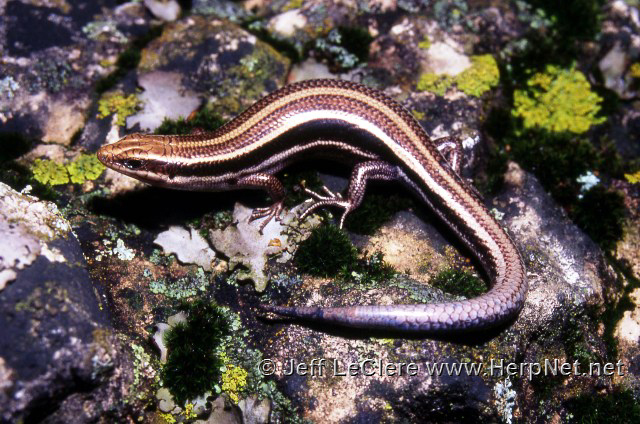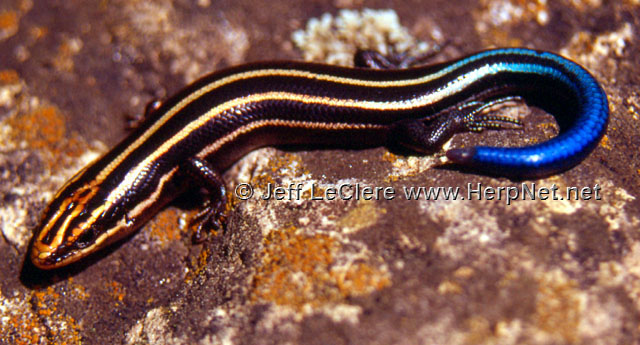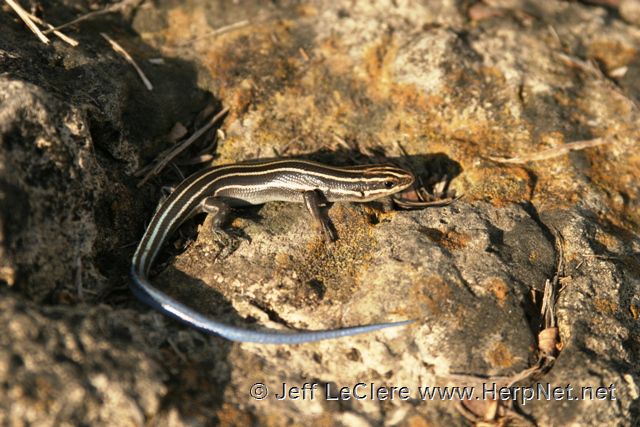Common Five-lined Skink (Plestiodon fasciatus)
by Jeff LeClere

Status
Species of Greatest Conservation Need. The common five-lined skink, although not a state listed species, is a species of concern in Iowa due to a restricted known range. The former scientific name for this species was Eumeces fasciatus. Although technically the common name is “common five-lined skink”, it does not reflect it’s overall abundance in Iowa.
Description
The common five-lined skink reaches 5 – 8 1/2 inches total length (Conant and Collins 1991). Scalation same as in prairie skink; smooth. Adults are brown or black with no pronounced color change on the sides with five light narrow stripes down the back and sides. These light stripes are always thinner than the spaces between them. The head is marked with a light V that stems from the mid dorsal stripe.
Older males may become a uniform gold brown or olive color with only faint traces of striping. Both striped and uniformly colored males develop orange lips during the breeding season like prairie skinks. Young have bright blue tails that fade in males, but the females tails may retain a blue-gray coloration.

Subspecies
There are no recognized subspecies of the common five-lined skink, Plestiodon fasciatus.
Range
Common five-lined skinks are found in small, isolated populations in northeastern Iowa and range south along the Mississippi River in eastern Iowa.
Habitat
Common five-lined skinks favor wooded areas with granite or limestone rock outcroppings on the slopes of the blufflands near the Mississippi River.
Habits
Common five-lined skinks emerge from their winter dormancy in April depending upon the weather. They may bask atop rocks or logs and actively forage for their food. They are diurnal, but they often take refuge under rocks or logs during the hottest parts of the day in mid-summer. These skinks are accomplished burrowers and often form dugouts under rocks or similar cover. Common five-lined skinks are often found in small colonies around rock outcroppings in the open areas on bluffs. Here, as in Minnesota, these lizards appear to be absent on other parts of the same bluff or on similar bluffs in other areas. With good management practices, these open areas may be be inhabited by new populations of common five-lined skinks. Also, increased awareness by the general public may discover already established populations from new areas where they were previously unrecorded.

Breeding occurs in spring. The male grasps the skin of the female’s neck during copulation. They are oviparous laying about 10 eggs in June in small excavations under forms of cover such as rocks, logs or boards. Females guard the eggs and eat the ones that have spoiled (Oldfield and Moriarty, 1994). The eggs hatch in August. I have observed common five-lined skinks hatching in Jackson County, Iowa. on August 21. There were several nests discovered under shingles laying on the forest floor high up on a bluff. All nests had females in attendance. Clutch size ranged from five to twelve. The young were jet black with five thin, yellow lines down the back and had bright blue tails. They were a little over 2 inches at hatching.
All of Iowa’s lizards are quick and rely on speed to escape when they are out and about. The skinks look like small snakes slithering through the brush as they move their bodies in a very serpentine way when they run. One must use caution when trying to capture skinks. Often one will end up with nothing but a wriggling tail as the lizard scoots off to safety. Skinks may also break their tails off by themselves by pushing the tail against a solid structure. The tail will regenerate, but it will have no pattern, will have slightly different scalation, and will never be as long as the original one.
Common five-lined skinks overwinter in rock crevices and tunnels. They usually begin overwintering in September, and adults may enter dormancy before juveniles.
Food
All five species of Iowa’s lizards eat small invertebrates such as crickets, grasshoppers, beetles, spiders, caterpillars, which they chase down and eat. They mash their food up with their strong jaws before swallowing their prey.

